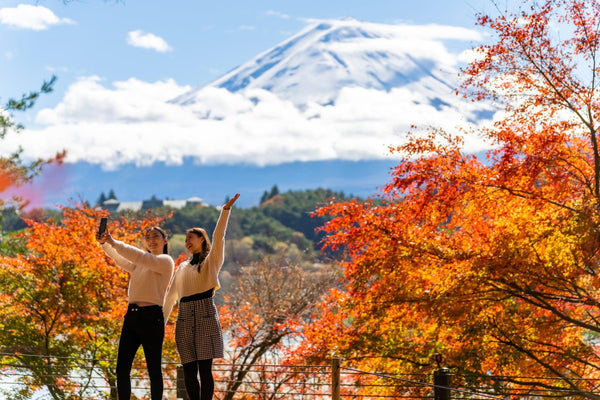Japan Fall Foliage Guide 2024: Forecast, Map, Best Spots, & Travel Tips

Jump to:
This year’s foliage is surely as breathtaking as ever, with vibrant shades of red, orange, and yellow transforming landscapes into a stunning tapestry of color.
Each region’s peak brings its own unique beauty, making autumn in Japan an unforgettable experience.
The golden hues of ginkgo leaves are predicted to peak in late November in Tokyo, Osaka, and Nagoya and early December in Fukuoka.
While, the red maple leaves are expected to peak around the first week of December in Tokyo and Sendai and around the second week in Osaka, Sapporo, Nagoya, and Fukuoka.
Yellow Foliage Forecast
- Sapporo: 11/6
- Sendai: 12/3
- Tokyo: 11/29
- Nagoya: 11/22
- Osaka: 11/28
- Fukuoka: 12/1

Red Foliage Forecast
- Sapporo: 11/8
- Sendai: 12/1
- Tokyo: 12/5
- Nagoya: 12/8
- Osaka: 12/8
- Fukuoka: 12/13

For the most current and detailed updates on autumn foliage across Japan, including daily reports and regional specifics, you can refer to this website.
What to Expect This Year's Autumn Season
Fall colors in Japan result from a combination of factors. The gradual temperature drop triggers chemical changes in deciduous trees, particularly Japanese maples and ginkgo trees. Japanese maples turn lovely shades of red & orange, while ginkgo trees transform into golden yellow.
Local weather patterns significantly impact the intensity of these colors; sunny days paired with cool nights are ideal for producing the most vivid hues.
This year, however, Japan has experienced an unusually warm year, with high temperatures extending through September and even into October in many areas. According to forecasters, this prolonged warmth may delay the peak of autumn colors in 2024.
Best Locations for Fall Foliage Viewing
There may be no single "best" location for fall colors in Japan, as it truly depends on your timing and travel route. However, here are some favorite spots for experiencing Japan’s autumn foliage, each offering unique scenic beauty and atmosphere.
Hokkaido: Autumn in Northern Japan
Hokkaido is a great spot if you’re visiting Japan in the early fall weeks/months. Fly into Sapporo (from either Tokyo or Osaka) and start your journeys around the island.
Daisetsuzan National Park (accessible from Asahikawa or Sapporo) usually kicks off Japan’s fall foliage season, starting in late September (in a typical year). The park spans a vast area with differing scenery, like alpine meadows and dense forests.
The Asahidake Ropeway zooms you up to high-altitude viewing spots, ideal for those who want to experience the colors without strenuous hiking.
But this park offers various hiking trails suitable for all skill levels. The Ginsendai trail particularly impresses visitors with its cool views and good accessibility. Early morning hikers can often find themselves walking through clouds.
Onuma Park near Hakodate offers a different perspective. Here, the fall colors reflect in the calm waters of Lake Onuma, with Mount Komagatake in the background. The park features easy walking trails that circle the lake.
Kyoto: Fall Colors in Japan’s Old Capital
Kyoto's temples and gardens become extra special in the autumn weeks/months. Kyoto’s quintessential architecture complements the natural beauty of the season, giving visitors something to remember and cherish.
Arashiyama district combines its famous bamboo groves with amazing maple displays. The Togetsukyo Bridge area provides classic views of the mountainside ablaze with color. But this area is no secret, so plan ahead and get here early.
Just outside the city, in the hills north of Kyoto, are the Maple Tree Tunnel (exactly what it sounds like!) and an array of sites that feature fall colors, such as Kifune shrine, Kuramadera temple, Sanzen-in, Jisson-in, Enryaku-ji, Saimyo-ji and many other temples & gardens that draw some crowds but far fewer than uber-popular Kiyomizu-dera (still worthwhile, just go early or be prepared for packed tourist city!).
Across Kyoto (and elsewhere in Japan) restaurants serve seasonal specialties featuring autumn ingredients.
Tofukuji is a temple that’s popular with Japanese locals, though these days draws plenty of international visitors as well. Its famous bridge views are at their finest in the fall. Tofukuji’s garden design specifically showcases autumn colors, with different species of maple creating a layered effect of reds and oranges.
Shimogamo & Kamigamo are shinto shrines that have lovely fall colors in Kyoto with manageable crowds. These are just some of the many possibilities in and around Kyoto that give you great foliage options in the autumn time.
Nikko: Day Trip or Overnight from Tokyo
Just a few hours from Tokyo, Nikko National Park has some amazing autumn scenery. The area combines natural beauty with historical significance, home to some of Japan's most important shrines and temples.
Lake Chuzenji gives reflections of autumn colors in its clear waters. The lake shore drive presents numerous photo opportunities, with Mount Nantai often visible in the background. Boat cruises give unique viewing angles.
Kegon Falls becomes even more impressive when framed by fall colors. The observation deck provides close-up views of both the falls and the surrounding foliage.
You can experience Nikko best on an overnight, but many travelers come here on a day trip from Tokyo (which itself has some good fall foliage options).
Quick Tips for Your Autumn Visit in Japan
To make the most of your experience, here are some quick tips for enjoying Japan’s autumn colors comfortably and avoiding crowds at popular spots.
- Book Accommodations Early: Popular areas like Kyoto fill up months in advance during peak foliage season. Traditional ryokan inns release rooms about six months ahead, and they go quickly. If Kyoto is fully booked, consider Osaka or Otsu as alternatives.
- Early Morning Visits: Arriving early at popular spots not only gives you better lighting for photos but also fewer crowds. Morning light filtering through maple leaves creates stunning effects, and the cooler temperatures make for comfortable walks.
- Evening Illuminations: Many shrines and temples offer special evening “raito app” (light-up) events during autumn. These illuminations create a magical atmosphere and are worth experiencing if your visit aligns with them.
- Opt for Weekday Visits: Local residents and tourists crowd popular spots on weekends, so visiting during the week can improve your experience.
- Prepare for Temperature Variations: Autumn temperatures in Japan fluctuate, often cool in the morning and warm in the afternoon. Dress in layers to stay comfortable, and keep basic skincare items on hand to protect your skin during long days outdoors.
Want to know more essential tips for exploring Japan? This Japan travel guide covers everything from booking flights and accommodations to savoring local cuisine and navigating Japanese cultural etiquette.
Skincare Tips for Cooler Months
As the crisp air of autumn settles in, adapting your skincare routine can make all the difference in keeping your skin comfortable and glowing. Here are some essentials for the season, inspired by trusted recommendations and personal favorites, perfect for fall travel in Japan.
Sun Protection
Even in cooler weather, UV rays remain strong, making sunscreen an essential part of your daily routine. Opt for a lightweight sunscreen that’s easy to reapply, especially if you’re spending a lot of time outdoors. Look for sunscreens that absorb quickly, layer seamlessly under makeup, and offer options for targeted application or all-day protection. For a touch of glow, tone-up sunscreens are a fantastic choice, brightening your complexion while safeguarding your skin from the sun.
Moisturizer
Autumn’s drier air calls for a rich moisturizer that locks in hydration and helps your skin transition from the humidity of summer. Seek out creams packed with ceramides or hyaluronic moisturizer, as these ingredients replenish moisture and reinforce your skin barrier. Some options also offer anti-aging benefits, leaving your skin feeling plump and looking radiant.
Mist or Face Spray
A hydrating face mist is a convenient companion for on-the-go moisture. Perfect for refreshing your skin during the day, mists with plant-based or face spray with hypoallergenic properties are particularly suited for sensitive skin. These lightweight sprays not only maintain your skin’s hydration but also create a smooth finish over makeup.
Lip Care
Dry, chapped lips can be a common challenge in cooler months. Protect and hydrate your lips with nourishing balms that provide long-lasting moisture. For a hint of color, tinted balms are an excellent choice, combining hydration with a glossy, plump look.
Facial Masks
After a day of exploring, a facial mask can rejuvenate your skin, restoring moisture and reducing the signs of fatigue. Look for masks infused with ingredients like rice-derived or anti-aging formulas to soften fine lines and deeply nourish your skin, leaving you refreshed and ready for another adventure.
Autumn in Japan Awaits You
Success in enjoying Japan's autumn colors requires flexibility and staying updated on forecasts and local conditions. Many Japanese gardens, shrines, and temples share regular fall color updates on their social media platforms, such as Instagram, X, and Facebook, allowing visitors to plan their visits perfectly during the peak season.
Beyond the stunning foliage, autumn in Japan offers a sensory feast with seasonal foods and festivals that enhance the experience.
Have you experienced Japan in the fall, or are you planning a trip soon? Share your thoughts and plans with us in the comments below!






0 comments